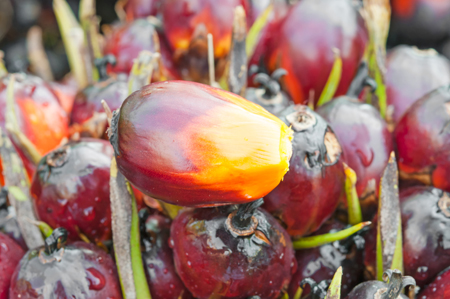 (Agrimoney) – Oil futures started the week on a negative note, hitting a fresh five-year low of $49.59 a barrel, for Brent crude.
(Agrimoney) – Oil futures started the week on a negative note, hitting a fresh five-year low of $49.59 a barrel, for Brent crude.
Meanwhile, in what would appear a second negative for agricultural commodities (many of which are used in making biofuels), the dollar rose 0.4% against a basket of currencies.
A stronger dollar undermines prices of dollar-denominated commodities by making them less affordable to buyers in other currencies
Still, agricultural commodity investors have bigger fish to fry today even than these considerations, with Monday bringing a slew of data.
‘Heavy rain again’
The first set has already been unveiled, with the Malaysian Palm Oil Board revealing that Malaysian stocks of palm oil dropped in December to a five-month low, sapped by the dent to production from floods.
At 2.01m tonnes, December inventories were only 10,000 tonnes lower than forecast.
And there is the prospect of further disruptions to production.
“Malaysia is slated to get heavy rain again across the large producing states of Johor and Pahang, threatening January palm production,” said Terry Reilly at Chicago-based broker Futures International.
Kuala Lumpur March futures added 0.9% to 2,370 ringgit a tonne as of 09:30 UK time (03:30 Chicago time.
‘Look for softer tone’
The main course of data, however, comes later when the US Department of Agriculture reveals its January Wasde crop report, with final estimates for domestic corn and soybean output last year, plus briefings on grain inventories and winter wheat sowings too.
The investor mood heading into the data has been somewhat negative.
“It feels like the bulk of the trade favours going into Monday’s report positioned for lower price action,” said Brian Henry at Benson Quinn Commodities, thinking in particular of corn.
Richard Feltes at RJ O’Brien advised investors to “look for softer tone” in trading “as longs head to the sidelines” in the run-up to the data.
‘Aren’t real spiffy’
In fact, there was not too much movement in grains in early deals, in line with the recent tone in Chicago, where investors have tended to wait for US trading hours for direction.
Corn did feel selling pressure, but not that much standing 0.1% lower at $3.99 ¾ a bushel for March delivery, if being enough to send the contract below the $4-a-bushel mark.
There has been talk of increased producer selling, particularly in the US western Corn Belt,
And from a chart perspective, “the technicals in the corn market aren’t real spiffy”, Mr Henry said.
‘Makes senses for China to import’
Still, the inability of the March contract to push below its 50-day moving average “has taken some of the pressure off”, he added.
Furthermore, sticking on technical aspects, hedge funds have trimmed potential selling pressure ahead by cutting their net long position in Chicago corn by more than 13,000 contracts in the week to last Tuesday, US regulatory data showed.
And, from a fundamental perspective, CHS Hedging flagged “some rumblings that China may have purchased a couple of cargos of [US] corn”.
This after the fulfilment of a Ukraine order of some 1m tonnes, of which about 20% had appeared at risk.
“It makes senses for China processors to import corn, regardless of the large production,” Futures International’s Terry Reilly said.
“The average China cash corn price was $9.43 a bushel as of Friday, compared to $9.46 from late last week and $9.72 at this time last year.”
Weather concerns
Furthermore, South American weather remained somewhat supportive to prices, provoking some extreme dryness/wetness worries, if not extreme ones.
In Brazil, “showers this week in Rio Grande do Sul will increase wetness concerns,” weather service MDA said.
“On the flip side, mostly rain-free weather in Goias and Minas Gerais will increase dryness concerns.”
In Argentina, “moderate-to-heavy rains will continue in northern Santa Fe and Entre Rios thus increasing wetness and disease threats”, US-based MDA said, flagging the prospect that “dryness will continue” in south west Buenos Aires province too.
Crush margins
But this provided a prop in the main for soybeans – which edged 0.1% higher to $10.53 ¼ a bushel in Chicago for March delivery.
Terry Reilly noted that spot crush margins “are still at high levels”, rewarding processors for buying soybeans.
“Cash crush has been under pressure on easing soymeal prices, but are very high for this time of year,” he said.
Indeed, many investors are “looking for a record US crush” figure from further data this week, from the National Oilseed Processors Association, due on Thursday.
‘Global supplies are plentiful’
Still, this time it was wheat which led Chicago’s big three, rising 0.3% to $5.65 ½ a bushel, contrary to its recent weakness.
Sure, “the Russian tax implementation and the seriously cold temperatures lurking over the US Midwest seem to have exhausted their ability to push prices higher,” CHS Hedging said.
And many would agree that “global wheat supplies are plentiful and the US is clearly not the market for wheat”.
‘Premium gone’
But there are signs that US wheat may at last, thanks to its price-reversal since December 18, be getting more into the zone world competitiveness.
A price of $5.50 a bushel “will mean the premium for Russian export worries will largely have gone”, Tobin Gorey at Commonwealth Bank of Australia said.
“March Kansas City hard red winter wheat is already there,” and added 0.2% to $6.01 ½ a bushel, managing to consolidate around the $6-a-bushel mark.
As a negative, Ukraine’s farm ministry, which hold talks with grain merchants on Tuesday, said it had no plans for export curbs, and said it was upbeat too on prospects for this year’s harvest.




